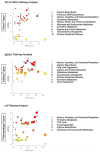Comparative Untargeted Metabolomic Profiling of Induced Mitochondrial Fusion in Pancreatic Cancer
- PMID: 34564443
- PMCID: PMC8470144
- DOI: 10.3390/metabo11090627
Comparative Untargeted Metabolomic Profiling of Induced Mitochondrial Fusion in Pancreatic Cancer
Abstract
Mitochondria are dynamic organelles that constantly alter their shape through the recruitment of specialized proteins, like mitofusin-2 (Mfn2) and dynamin-related protein 1 (Drp1). Mfn2 induces the fusion of nearby mitochondria, while Drp1 mediates mitochondrial fission. We previously found that the genetic or pharmacological activation of mitochondrial fusion was tumor suppressive against pancreatic ductal adenocarcinoma (PDAC) in several model systems. The mechanisms of how these different inducers of mitochondrial fusion reduce pancreatic cancer growth are still unknown. Here, we characterized and compared the metabolic reprogramming of these three independent methods of inducing mitochondrial fusion in KPC cells: overexpression of Mfn2, genetic editing of Drp1, or treatment with leflunomide. We identified significantly altered metabolites via robust, orthogonal statistical analyses and found that mitochondrial fusion consistently produces alterations in the metabolism of amino acids. Our unbiased methodology revealed that metabolic perturbations were similar across all these methods of inducing mitochondrial fusion, proposing a common pathway for metabolic targeting with other drugs.
Keywords: fission; fusion; leflunomide; metabolomic reprogramming; metabolomics; mitochondrial morphology; mitofusin-2; pancreatic cancer.
Conflict of interest statement
C.M.T. was on the clinical advisory board of Accuray during this study, has a patent for oral amifostine as a radioprotectant of the upper GI tract issues that is licensed with royalties paid from Xerient Pharmaceuticals, and PHD inhibitors as a radioprotectant of the GI tract pending, and was the lead principal investigator of a multicenter trial testing the effects of high-dose SBRT with the radiomodulator, GC4419. All other authors declare no conflict of interest.
Figures






References
-
- Hollinshead K.E.R., Parker S.J., Eapen V.V., Encarnacion-Rosado J., Sohn A., Oncu T., Cammer M., Mancias J.D., Kimmelman A.C. Respiratory Supercomplexes Promote Mitochondrial Efficiency and Growth in Severely Hypoxic Pancreatic Cancer. Cell Rep. 2020;33:108231. doi: 10.1016/j.celrep.2020.108231. - DOI - PMC - PubMed
Grants and funding
LinkOut - more resources
Full Text Sources
Research Materials
Miscellaneous

